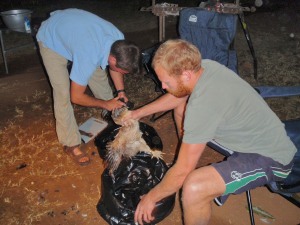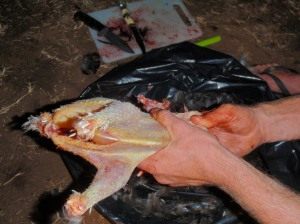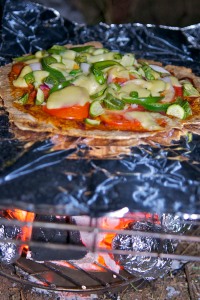I think a lot of people have preconceived notions of camping food. Hamburgers and hotdogs may come to mind, baked potatoes wrapped in tin foil thrown in the fire, maybe marshmallows roasted on a stick for smores. All of those things are good but truthfully a bit limiting to what you can make outside of the kitchen. I have found that anything you can make at home you can make on the campfire, you may need a little more creativity and a extra dose of patience. In two months we ate maybe one stereotypical camping meal.
Cooking Methods
Potjiekos – “Pot food”
Fire Roasting
Camp Made Pizza Oven
Cast Iron Bread Pan
Boiling
Frying
Grilling
Haystack
Spit Roasted Fresh Chickens – Since the start of our trip Merv and I have been eyeing up the live chickens for sale on the side of the road. We really wanted to buy one but were a little intimidated by the whole process. While we were staying in Lilongwe we met a guy named Jon who had driven his landy down from the UK and was making his way through Africa. We were sharing a meal with Jon one night and chatting about camp cooking. Jon mentioned that he buys chickens live while he’s on the road. Our eyes lit up and we insisted that he show us how to prepare a chicken from scratch.
With out getting into the gory details this is how we did it. Kill the chicken. Let the blood drain while you pluck the feathers (this is best done immediately while the chicken is still warm, the feathers come out easiest). After plucking the chicken you take the wings off. At this point you have a fairly clean bird and now must remove the innards carefully as to not contaminate it. The final step is washing it out real good in clean water. Your chicken is now ready to prepare to your liking. We choose to stuff our chicken with lemon and garlic cloves.
Note: Spit roasting is not the best cooking method for village chickens. The meat was very tough. The chickens spend their existence running around dodging people and cars. This makes their muscles more developed. It is best to slow roast the chicken in liquid.
Pizza – The preparation process is the same as at home. Make your dough, roll it out and top with whatever is in your refrigerator. We were missing one key link in the cooking process and had to get creative. The heat comes up from the fire but we needed to trap it around the pizza. Merv came up with tinfoil around a gas bottle holder. It worked great because we were able to lift it on and off to check the pizza.
Curry – A very easy one-pot meal that can be cooked over the fire. We started by sautéing the onions, peppers, and garlic, then added the mince and let it slow cook for about an hour and a half. The final step as tossing in the fresh basil before serving. This recipe was one of Merv’s from his time in Thailand. We served it with a fried egg, rice and fresh green beans.

Cooking with a potjiekos is a South African tradition that goes back to the first dutch settlers. The pots are able to retain heat and keep its contents at a simmer with only a few coals. They are efficient and effortless and therefore ideal for cooking in or out of the kitchen.
Beef Fajitas – By far one of the most delicious and easiest things I made. I started with a base of onions and chilies on the bottom of the potije. A large roast was layered on top then covered with a can of beer and a can diced tomatoes. The potjie sat in the fire for over 3 hours. As the meat began to cook I cut the roast into chunks so that it would cook more evenly. I let the liquid reduce until a rich sauce was left with tender meat morsels. Truly divine!
Goat Stew with Pup – Dodging goats running across the street has pretty much been a constant during the trip. They are everywhere yet I have not seen any meat for sale. While in Chipata, Zambia I finally saw goat meat for sale in the grocery store. The meat looks very similar to beef. I decided to make a stew out of it and serve it the traditional African way with pup as they call it in South Africa or insima as it is called in Malawi and Zambia. A large portion of the African diet is corn meal. Very similar to polenta or grits you just cook it to different consistencies. With the pup you cook it to a very thick consistency but not stiff like mash potatoes. For insima they process it to a point where you can pick it up with your hands and dip it into your stew. To cook the stew I tried out a method called haystack cooking. Put all your ingredients in a potjie and bring it to a boil, take the pot off the heat and do not open the lid as this will break the heat seal, wrap a dish cloth around the potjie, place it in a plastic bag, wrap the bag in tin foil with the shiny side in, further insulate by wrapping in a large blanket or sleeping bag. I let mine sit for four hours since we were out on safari. We came back to a steaming hot fully cooked goat stew that we ate with the pup.





Pesto – We have a hand blender that plugs into our inverter in the landy. I found beautiful basil in Maputo that we used in the curry shown above. There was quite a bit left over so pesto came to mind. I did not have pine nuts or parmesan but lack of ingredients should never get in your way, simply improvise and substitute as needed. This one below had basil, fresh garlic, chilies, olive oil, sea salt and cracked pepper.
Catch of the day – Fish was often available from local fisherman while we were in Mozambique. I’m not sure what type this one is below but it was delicious. We kept the preparation simple and the fish cooked it self on the fire.
Bread – Banana, olive, yogurt, whole wheat, mayonnaise, and beer breads were on the menu during the trip. I tried almost everyone in the 4×4 cookbook. I would make them all again minus the mayonnaise bread. The process is the same as at home you just cook it in the fire instead of the oven. The fire can be a little temperamental, it’s important for the coals to be just right. If they are too hot your bread just burns. We found that putting the bread on the fire after making dinner worked well.
Birthday Cake – We celebrated Merv’s birthday on the road. I used my bread pot for a cake pan and cooked it in the fire. I did not have the ingredients for icing so I melted a mint chocolate bar instead. It worked great!
Banana Fritters – Bananas have been plentiful along the road. They are being sold in large bunches that look like they just came off the tree. It is nearly impossible to get through a bunch before they start to become brown. Fortunately, that is when they are just reaching their peak for baking. Before the trip I bought a cookbook specifically for bush cooking. I had wanted to try one of their dessert recipes and all the ingredients for banana fritters were present. Frying has always been a little intimidating for me. I usually leave it to the professionals. I learned that things always seem harder then they are before you try. We used our potije and an inch and a half of cooking oil. The batter was simple with eggs, flour, milk, and sugar but I substituted the fresh honey bought on the road that day. Spoonfuls of the batter were dropped in the oil and cooked until they were golden brown on both sides. A spaghetti scoop turned out to be a great tool to flip the fritters and drain the oil off. The fire provided a perfect even heat source.
Road Side Lunch – Sandwiches with cold roasted butternut squash slices.
Grilled Breakfast Sandwiches
















